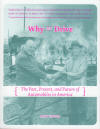Why We Drive
Microcosm Publishing’s Why We Drive: The Past, Present, and Future of Automobiles in America is an image-rich examination of the dominance of car culture in the United States. “I am an advocate for car-free cities, car-free city sections, and car-free living,” author/illustrator Andy Singer states within the first few introductory pages. The text proceeds from there, detailing the disadvantages of arranging urban and suburban life around cars rather than people. This is followed by a succinct history of highway politics in the United States, and Singer concludes with a call to action, offering suggestions for individuals who wish to live car-free and strategies for funneling more money into public transportation at the state level.
Microcosm Publishing’s Why We Drive: The Past, Present, and Future of Automobiles in America is an image-rich examination of the dominance of car culture in the United States. “I am an advocate for car-free cities, car-free city sections, and car-free living,” author/illustrator Andy Singer states within the first few introductory pages. The text proceeds from there, detailing the disadvantages of arranging urban and suburban life around cars rather than people. This is followed by a succinct history of highway politics in the United States, and Singer concludes with a call to action, offering suggestions for individuals who wish to live car-free and strategies for funneling more money into public transportation at the state level.
Why We Drive is a difficult book to categorize; more than half of its pages are devoted to photographs, cartoons, and infographics, while the text functions as a persuasive and generally well-structured argument. The book bears similarities to a manifesto, a graphic novel, and a zine, but it isn’t entirely any of these things.
Visually, this is an appealing book. The photographs are well chosen to support the text, and Singer’s line drawings are excellent, with a clean, high-contrast aesthetic that reproduces well. However, a few typographical missteps detract from the readability of the text. From page to page, the text is formatted in a jumble of typeface sizes and styles, frequently with inconsistent page breaking and centering. Some pages contain single paragraphs, as if they are merely captions accompanying the preceding image, while others run full text, making it easy to misconstrue some information as erroneously more important than the rest. On some pages it’s also difficult to visually discern the footnotes from the text itself. The lack of consistency is distracting, and a more unified style would serve the text better overall.
Regardless, Singer makes a well organized argument, beginning with a series of examples detailing the varied ways cars impact people and neighborhoods. His writing style is generally clear and well paced, aiming for pertinent and interesting arguments rather than scholarly detail. Footnote citations and a bibliography back up Singer’s claims and statistics and will allow interested readers to pursue the subject matter in further detail. Some points made early in the book feel a bit predictable (doesn’t everyone know by now that cars cause air pollution, and that driving rather than walking/biking can be a factor contributing to obesity?), but the research on less commonly reported effects of automobile use in the United States pays off handsomely. Much of the information is very compelling, as in the discussion of the impact of cars on the American landscape, creating urban dead zones and suburban sprawl.
As Why We Drive moves on to the topic of highway development, the text becomes more thorough. The history of highway development in the United States is detailed and very interesting. Singer discusses strong-arm tactics used by the automotive industry in developing highway systems in the 1930s and 1940s, the systematic dismantling of existing public transit systems, and the financial and social systems that perpetuate highway construction and inhibit public transit funding to this day.
The book concludes with suggestions for reducing the impact of cars in the future, ranging from large goals like amending state constitutions to allow gas tax flexing to individual steps like joining bike advocacy groups. The tone of the conclusion is encouraging and optimistic rather than negative, and several pages of alternative transportation groups and resources are included after the bibliography, offering an excellent starting point for readers interested in exploring car-free options or advocating for public transit.
Singer’s graphics are engaging, and his message is explicit and well researched. Published by Microcosm Publishing, a self-described “small, charming, and radical publishing house” based in Portland, Oregon, the pocket-sized Why We Drive occupies a liminal space between zine manifesto and political cartoon, making it difficult to categorize but refreshingly atypical and accessible. Casual readers will find much to enjoy here, and readers with mixed feelings about cars and car dependency will come away from Why We Drive with a great deal of food for thought.





